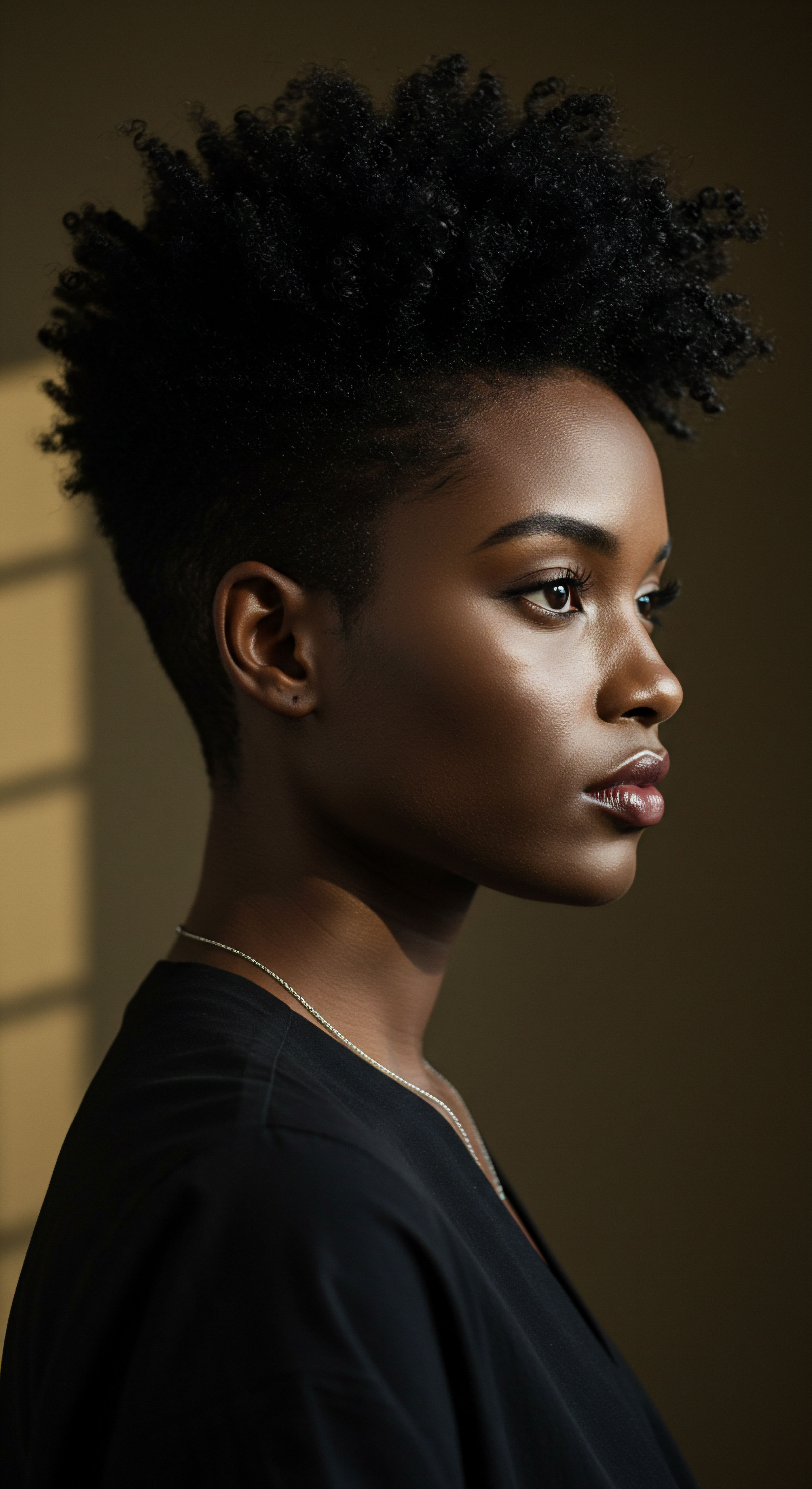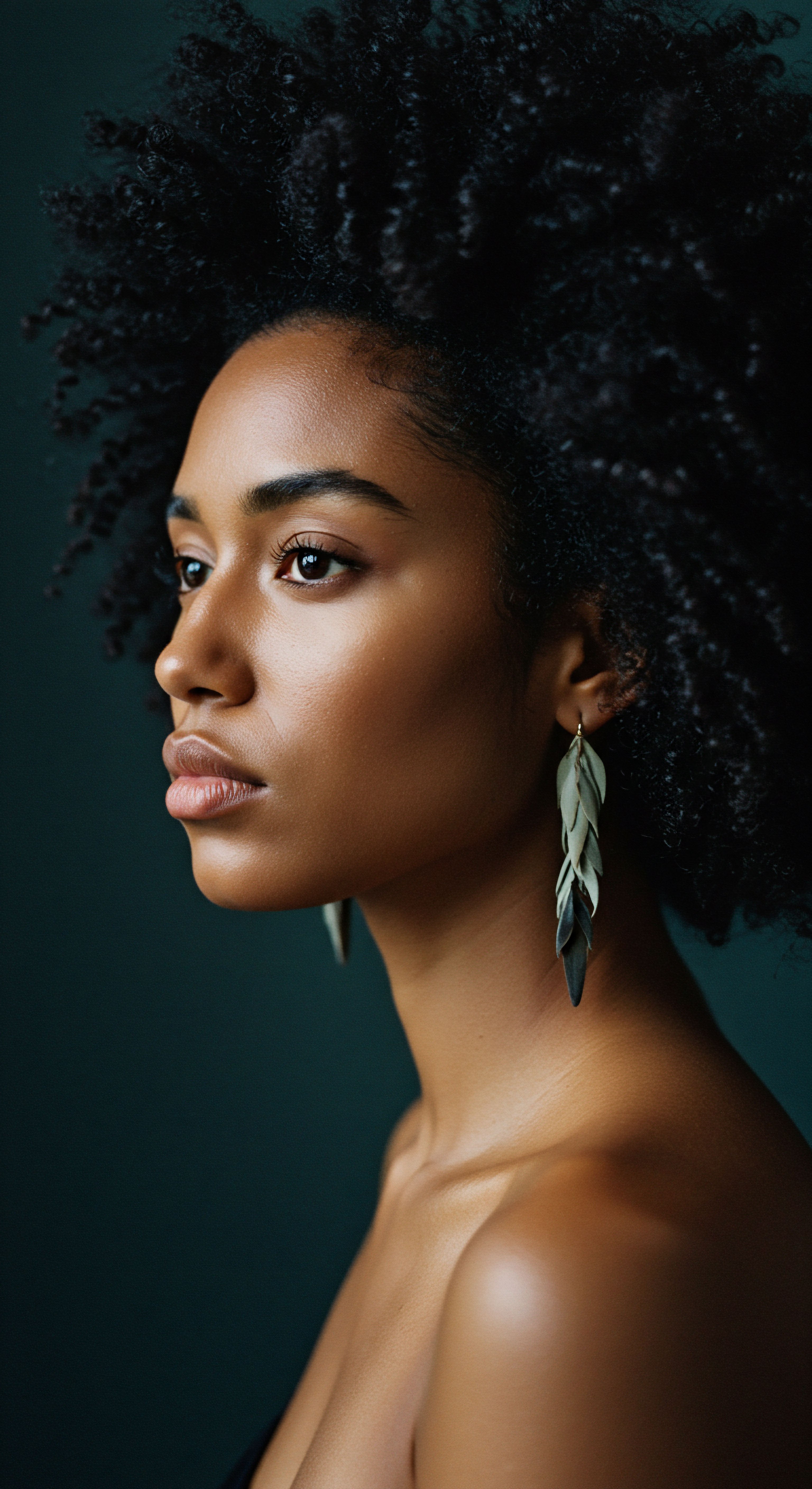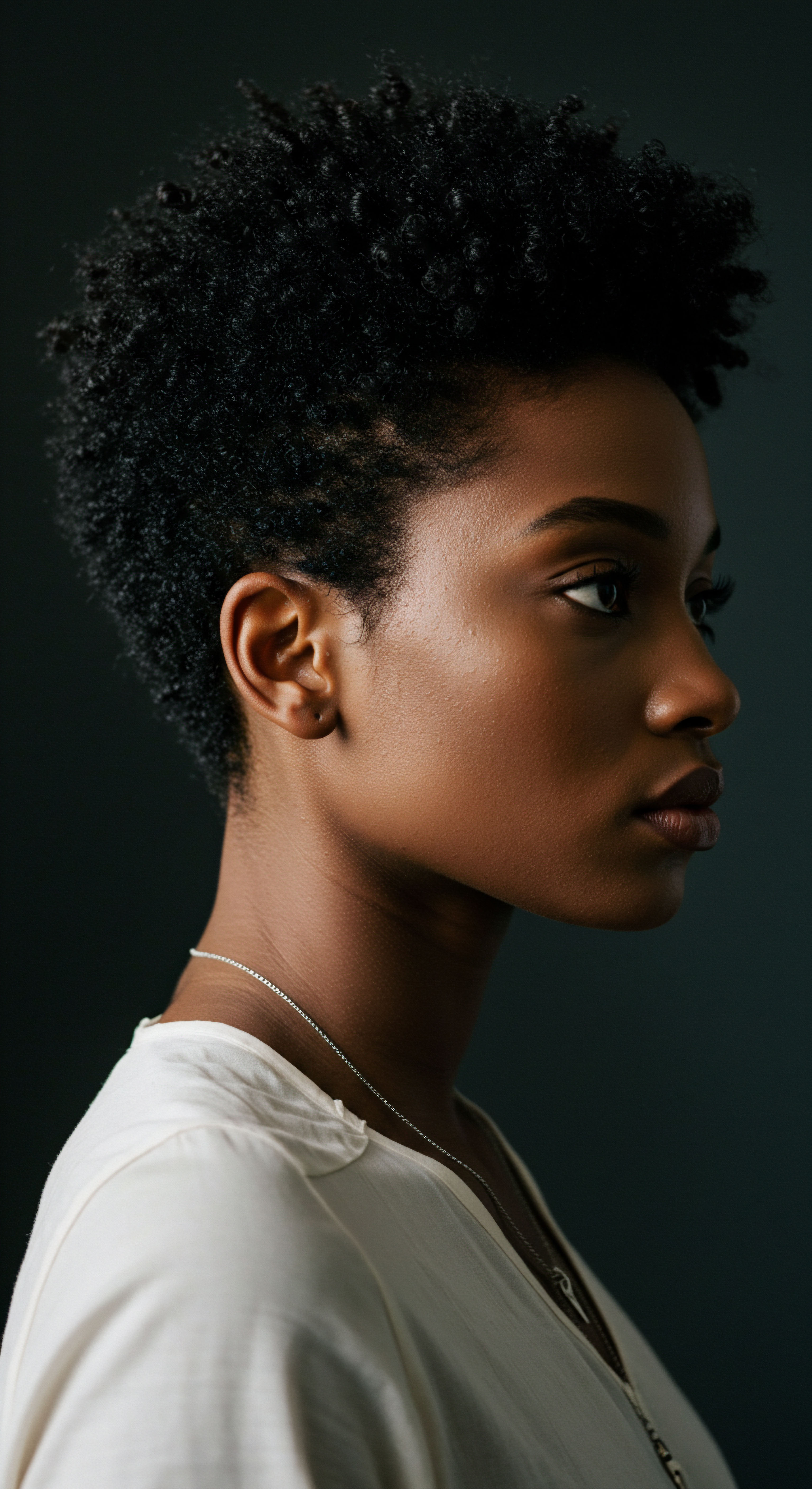
Roots
The quiet hum of an ancient story often begins not with a roar, but with the subtle rustle of leaves, or perhaps, the gentle spring of a coil. To truly understand how historical practices acknowledged hair’s natural curl, one must first listen to the whispers of time, recognizing that hair, in its myriad forms, has always been a living canvas, a marker of identity, status, and spirit. Before the advent of modern chemistry and its sleek promises, humanity observed, adapted, and celebrated the inherent tendencies of strands, crafting ingenious methods from the earth and their hands. This foundational exploration delves into the earliest acknowledgements of curl, revealing how societies understood and interacted with hair’s intrinsic patterns, long before the language of curl types became commonplace.

Early Observations of Curl Patterns
Across continents and epochs, the distinct spiraling nature of curly hair was not merely seen; it was deeply understood as a biological reality. Ancient civilizations, lacking microscopes or advanced trichological insights, relied on keen observation and empirical knowledge. They recognized that some hair grew in tight coils, others in looser waves, and still others in broader undulations. This observation directly influenced the tools and techniques developed.
For instance, archaeological finds suggest that early combs, crafted from wood, bone, or ivory, often featured wide teeth, ideal for navigating the natural density and curl of textured hair without causing undue breakage. The design of these rudimentary implements speaks volumes about an intuitive grasp of curl’s physical characteristics, prioritizing gentle detangling over forceful straightening.
Early civilizations intuitively understood hair’s curl, crafting tools and practices that respected its natural form.
In many African societies, for example, hair was seen as a profound symbol of identity, age, marital status, and even spiritual beliefs. The natural curl patterns were not merely tolerated; they were revered and incorporated into intricate styles that communicated complex social information. The inherent spring of the hair allowed for styles of impressive height and volume, which in some cultures, symbolized a connection to the divine or elevated social standing. This deep respect for natural texture meant practices were developed to work with, rather than against, the hair’s natural inclinations.

What Did Ancient Peoples Use for Hair Maintenance?
The ingenuity of ancient hair care lay in its reliance on natural resources and the wisdom passed through generations. Before synthetic compounds, the earth provided a wealth of ingredients that served to cleanse, moisturize, and hold natural curl.
- Natural Oils ❉ Many cultures, particularly in West Africa and ancient Egypt, used a variety of plant-derived oils and butters. Castor oil, almond oil, shea butter, and various plant oils were regularly applied to keep hair hydrated, protect it from harsh climates, and add a healthy sheen. These substances provided lubrication, helping to reduce friction and maintain the integrity of delicate curl strands.
- Botanical Extracts ❉ Herbal remedies were a cornerstone of hair care across the globe. In ancient India, Ayurvedic traditions incorporated herbs like amla and shikakai, along with coconut oil, to promote hair health and growth. Chinese women utilized rice water rinses and camellia oil for luster and strength. These botanical ingredients offered conditioning properties, enhancing the hair’s natural softness and manageability, which are vital for maintaining curl definition.
- Clays and Ash ❉ Certain cultures employed natural clays and ash, sometimes mixed with oils, for cleansing and conditioning. The Himba tribe of Namibia, for instance, famously coats their hair with a mixture of red clay, butterfat, and herbs, which serves both a cosmetic and protective purpose. These mixtures could provide structure and hold, allowing curls to set and retain their shape.
| Ingredient Category Plant Oils & Butters |
| Examples of Use Castor oil, Almond oil, Shea butter, Olive oil |
| Primary Function for Curl Moisture retention, lubrication, shine, environmental protection |
| Ingredient Category Botanical Extracts |
| Examples of Use Amla, Shikakai, Henna, Rice Water |
| Primary Function for Curl Cleansing, conditioning, strengthening, promoting growth |
| Ingredient Category Natural Clays & Ash |
| Examples of Use Rhassoul clay, Red clay mixtures |
| Primary Function for Curl Cleansing, absorbing excess oil, providing hold and structure |
| Ingredient Category Animal Fats |
| Examples of Use Ghee, various animal fats |
| Primary Function for Curl Deep conditioning, sealing moisture, creating protective barriers |
The consistent thread through these practices was a profound respect for the hair’s inherent structure and a focus on nourishment and protection. Rather than attempting to alter the curl pattern, these methods sought to enhance its natural beauty and resilience, providing the necessary elements for curls to flourish in their intended form.

Ritual
Stepping from the quiet contemplation of hair’s fundamental nature, we move into the vibrant realm of daily practice, where the hands-on wisdom of generations truly shines. For those whose strands coil and wave with a life of their own, the journey of hair care is often a deliberate dance, a series of thoughtful gestures that honor its unique disposition. This section delves into the techniques and routines, both simple and sophisticated, that ancient societies developed to tend to and style natural curl, transforming hair care into a ritual of self-expression and communal connection. It is here that we witness the practical application of foundational knowledge, revealing how historical practices meticulously accounted for the dynamic character of curly hair.

How Did Ancient Societies Style Naturally Curly Hair?
Ancient peoples, with their deep understanding of hair’s inherent tendencies, developed a range of styling practices that allowed natural curl to take center stage. These were not about imposing a foreign form, but rather about coaxing, defining, and securing the existing curl pattern. Braiding stands as a paramount example, appearing across diverse cultures from ancient Africa to Greece and Rome.
Braids, cornrows, and twists served not only as aesthetic statements but also as protective styles, shielding delicate strands from environmental elements and minimizing tangling. The density and spring of curly hair made these styles particularly enduring and versatile, allowing for intricate designs that could last for extended periods.
Ancient styling techniques for curly hair prioritized protection and definition, often through intricate braiding.
Beyond braiding, techniques for enhancing curl definition were also present. In ancient Greece, damp hair might have been wrapped around a smooth stick to achieve a corkscrew curl, a method that echoes modern-day curl-setting techniques. Roman women, particularly those of higher classes, utilized Calamistra, or curling rods, often heated over fires, to shape their prevalent textured hair into corkscrew curls and finger waves.
While primitive, these tools suggest an early pursuit of refined curl patterns, demonstrating an understanding of how heat could temporarily alter hair’s shape, albeit with risks of damage. The prevalence of naturally textured hair in classical art, often depicted in elaborate styles, further supports the idea that these societies actively styled and celebrated curls.

What Tools and Products Aided Historical Curl Management?
The tools and products of ancient hair care were born from necessity and a profound connection to nature. They were designed to work in harmony with the hair’s natural state, providing both utility and aesthetic enhancement.
- Combs and Hairpins ❉ The most fundamental tools, combs, were typically made from wood, bone, or ivory, often featuring wide teeth suitable for detangling curly and coily textures. Hairpins, sometimes elaborately adorned, were used to secure complex updos and braids, keeping styles neat and in place.
- Oils and Gels ❉ As discussed in the ‘Roots’ section, natural oils like olive oil, castor oil, and various plant oils were crucial for moisture and lubrication. Chemical analysis of an Egyptian mummy’s hair revealed a gel containing animal and vegetable fats, indicating early formulations designed to hold styles. These substances helped to reduce frizz and provide a gentle hold, allowing curls to remain defined without stiffness.
- Hairnets and Bands ❉ Ancient Greek and Roman women frequently used bands of cloth, leather, or metal, alongside elaborate hairnets, to gather and secure their hair. These accessories not only added decorative elements but also provided practical support for maintaining complex curly styles, preventing them from unraveling throughout the day.
A compelling case study illustrating the deep historical engagement with natural curl comes from ancient Egypt. While often associated with wigs, Egyptians also styled their natural hair. Wigs themselves, frequently long and full of curls or braids, were meticulously styled using tools like bronze curling tongs, some dating back to 1575-1194 BCE.
This demonstrates a sophisticated understanding of curl manipulation and the desire to replicate or enhance natural texture, even on artificial hair. The practices were not merely about hygiene or basic grooming; they were integral to social expression and personal presentation, reflecting a society that understood and valued the visual impact of well-maintained, naturally curly hair.

Relay
Having explored the fundamental recognition of curl and the practical rituals of its care, we now step into a more expansive view, one that connects ancient wisdom to broader cultural currents and the enduring significance of textured hair. This section asks us to consider the deeper currents of meaning that flowed through historical societies, influencing how natural curl was perceived, celebrated, or, at times, suppressed. It invites a thoughtful examination of the interplay between scientific understanding, societal norms, and the profound personal and collective identities expressed through hair. Here, we transcend mere technique, seeking the intricate layers of human experience woven into the very fabric of historical hair practices.

What Social and Cultural Meanings Did Natural Curl Hold in Antiquity?
The perception and styling of natural curl in antiquity were deeply intertwined with social status, religious belief, and cultural identity. Hair, in its natural state or meticulously styled, served as a powerful visual language. In ancient Rome, for instance, a woman’s hairstyle could convey her individuality, social standing, wealth, and profession.
While Roman elites often employed complex, artificial curls to display opulence, associating “natural” styles with “barbarians,” this very contrast underscores a keen awareness of hair texture as a social marker. The more elaborate and structured the curls, the more it reflected a woman’s ability to afford the time and skilled labor of hairdressers, known as Ornatrices.
Conversely, in many African societies before the transatlantic slave trade, natural hair was not just accepted but was a central element of identity and communication. Hairstyles, often showcasing the hair’s natural coil and volume, indicated age, marital status, tribal affiliation, and even religious beliefs. The act of hair styling was a communal event, a social opportunity for bonding and passing down traditions.
This collective care and reverence for natural texture stand in stark contrast to later periods where such textures were devalued. This deep cultural reverence meant that the natural curl was seen as an intrinsic part of one’s being, a source of spiritual power and connection to ancestors.
Hair’s natural curl historically communicated social standing and cultural identity across diverse civilizations.
The evolution of trichology, the scientific study of hair and scalp health, offers another lens through which to view historical accounting for natural curl. While formal trichology emerged in the 19th century, interest in hair health and its conditions dates back to ancient times. Ancient Egyptians, for example, developed remedies for hair problems and used ingredients like henna for hair health. This early, albeit rudimentary, understanding of hair biology suggests that even when styling focused on altering curl, there was an underlying awareness of hair’s inherent needs and vulnerabilities.

Did Historical Hair Practices Contribute to Hair Health Issues?
While many historical practices were rooted in nurturing hair, some, particularly those involving extreme manipulation or harsh substances, could lead to adverse effects, especially for naturally curly hair. The pursuit of specific aesthetic ideals sometimes overshadowed the long-term health of the hair and scalp. For example, the heated curling tongs (Calamistra) used in ancient Rome, heated directly over fires, presented a significant risk of scorching and damaging hair due to uncontrolled temperatures. Similarly, ancient dyes, which sometimes contained lead compounds or harsh ingredients like pulverized leeches, could cause hair loss.
One notable historical practice with potential long-term implications for hair health is the continuous tension from certain tight styling methods. While protective styles like braids and cornrows are often beneficial, their execution could, at times, lead to issues if done with excessive tension or without proper breaks. Modern trichological understanding highlights the risk of Traction Alopecia, a form of hair loss caused by prolonged pulling or tension on the hair follicles. While direct historical data on traction alopecia prevalence is scarce, the very nature of some tightly pulled styles, especially those worn continuously for extended periods, suggests this was a potential, albeit perhaps unacknowledged, consequence.
A study on the history of Black hair care practices notes that while African styling involved elaborate braids and cornrows, the mass enslavement of African populations led to practices that often stripped individuals of the time and resources to care for their hair, resulting in matting and damage. This forced neglect, combined with the subsequent societal pressures to conform to European beauty standards, often led to damaging straightening methods, further illustrating how external factors could compromise hair health.
The understanding of hair hygiene also played a role. Historical hair care manuals, particularly in the West, sometimes referenced “frequent” hair washing as being only once every two weeks, and often without modern soaps or shampoos. While this approach could preserve natural oils, it might also lead to product buildup or scalp issues that could impact hair health, particularly for dense, curly textures that require thorough cleansing to prevent scalp irritation. The shift towards more frequent washing in modern times, alongside the development of specialized cleansers, addresses these concerns, allowing for better scalp health and curl vitality.

Reflection
To truly understand the journey of hair, especially its natural curl, is to peer into a mirror reflecting humanity’s evolving relationship with self, culture, and the very essence of nature. From the earliest whispers of reverence for textured strands to the complex interplay of status, science, and societal expectation, the story of curl is a profound one. It speaks of adaptation, resilience, and the enduring human spirit that finds beauty in diversity.
This exploration reminds us that the wisdom of ancient hands, working with the earth’s bounty, laid a foundational respect for hair’s inherent form, a gentle echo that still guides our modern understanding of true hair wellness. Our ongoing conversation with our curls, coils, and waves is, in essence, a continuation of this timeless dialogue, a constant unfolding of self-acceptance and celebration.

References
- Byrd, Ayana D. and Lori L. Tharps. Hair Story ❉ Untangling the Roots of Black Hair in America. St. Martin’s Press, 2001.
- Dabiri, Emma. Twisted ❉ The Tangled History of Black Hair Culture. Harper Perennial, 2020.
- Feifer, Jane. “Roman Portraits.” In A Companion to Roman Art, edited by B. Borg, 233-51. Wiley-Blackwell, 2015.
- Rooks, Noliwe M. Hair Raising ❉ Beauty, Power, and Black Women’s Consciousness. Rutgers University Press, 1996.
- Salinger, David. The Hair Structure and Chemistry Simplified. Milady, 2005.
- Tassie, Geoffrey John. The Social and Ritual Contextualisation of Ancient Egyptian Hair and Hairstyles from the Protodynastic to the End of the Old Kingdom. University College London, 2014.